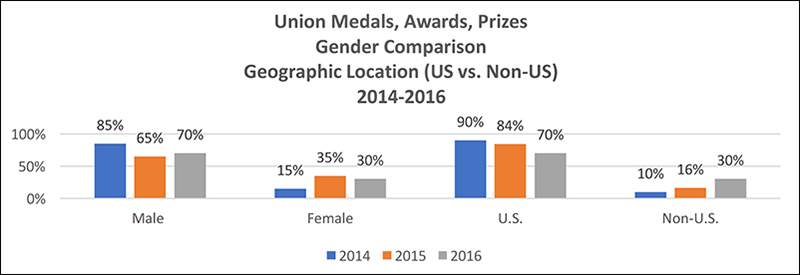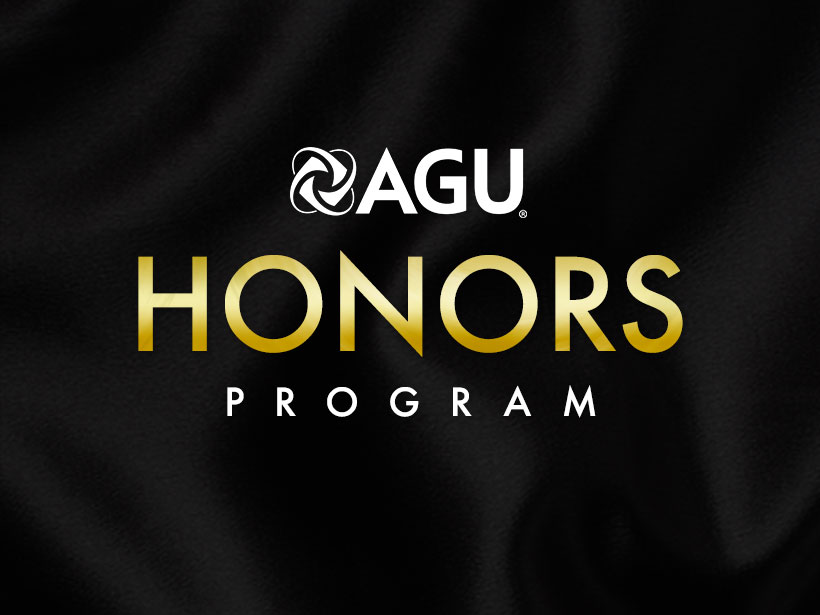During the past few years, the American Geophysical Union (AGU) has committed to growing, diversifying, and building a more transparent culture around its Honors Program and the nomination process for its various forms of recognition. The Honors and Recognition Committee, along with engaged volunteer members and AGU staff, has done an admirable job to improve the program and better align its awards with AGU’s vision and core values.
The AGU Honors Program promotes scientific leadership and collaboration, recognizes efforts to inform society about Earth and space science, and builds the global talent pool. The program extends beyond Union-level honors to yearly fellowships and numerous honors within AGU’s 23 sections and focus groups.
Key highlights and accomplishments for 2016 include the following:
- A newly established Union medal, the Devendra Lal Memorial Medal, will be given in recognition of “outstanding Earth and/or space sciences research by a scientist belonging to and working in a developing nation.” This new medal will be awarded for the first time in 2017.
- Two Africa Awards for Research Excellence in Earth and Space Science were given for the first time at the 2016 Honors Ceremony in recognition of two early-career scientists who are citizens or permanent residents of countries on the African continent.
- The Kaula Award, recently elevated in status, was given for the first time as a Union-level Award at the 2016 Honors Ceremony in recognition for “unselfish service to the scientific community through extraordinary dedication to, and exceptional efforts on behalf of the Union’s publications program.”
In addition to our key highlights and accomplishments in 2016, the AGU Honors and Recognition Committee, as well as AGU staff, implemented strategies and initiatives to improve diversity and to increase the number of nominations. In the spirit of transparency, we’re sharing the 2016 Honors Program demographic information to demonstrate our progress and areas for improvement.
Gender and International Diversity in the 2016 Honors Cycle
AGU has grown more diverse, with the percentage of women and non-U.S. members having grown dramatically over time. Table 1 shows that the percentage of non-U.S. members nearly doubled from 1975 to 2015 and has grown from 32% to 39% during the past 15 years. Since the year 2000, the percentage of women members has also grown from 15% to 27%.
| Table 1. AGU Membership | ||||||
| Year | ||||||
| 1975 | 2000 | 2005 | 2010 | 2014 | 2015 | |
| Approximate total AGU membership | 12,000 | 39,000 | 45,000 | 60,000 | 60,000 | 60,000 |
| Women members, % | Unrecorded | 15 | 17 | 20 | 26 | 27 |
| Non-U.S. members, % | 20 | 32 | 34 | 39 | 39 | 39 |
Overall, the data show gender diversity in AGU honors is approaching parity with the overall membership demographic; the international diversity performance in AGU Honors has improved by more than 10% across all AGU honors. Tables 2 and 3 show gender and international diversity data for 2016 nominees and honorees, respectively.
| Table 2. Demographic Information on 2016 AGU Medals, Awards, and Prizes Nominations | ||||
| Honor Type | Malea | Femalea | U.S. Members | Non-U.S. Members |
| Union awards | 80 (60%) | 57 (40%) | 96 (70%) | 50 (30%) |
| Union medals | 68 (80%) | 14 (20%) | 57 (70%) | 25 (30%) |
| Union prizes | 6 (90%) | 1 (10%) | 2 (30%) | 5 (70%) |
| Total | 154 (68%) | 72 (32%) | 155 (70%) | 80 (30%) |
| aGroup/program/team nominations for the Education Award omit gender demographic information. |
| Table 3. Demographic Information on 2016 AGU Medals, Awards, and Prizes Honorees | ||||
| Honor Type | Male | Female | U.S. Members | Non-U.S. Members |
| Union awards | 8 (50%) | 8 (50%) | 13 (80% | 3 (20%) |
| Union medals | 11 (80%) | 3 (20%) | 10 (70%) | 4 (30%) |
| Union prizes | 2 (100%) | 0 (0%) | 1 (50%) | 1 (50%) |
| Total | 21 (70%) | 11 (30%) | 24 (80%) | 8 (20%) |
Using data from the past 3 years, we have compared percentages of Union medals, awards, and prizes received by women and men. In Figure 1, bar graphs show this gender comparison from 2014 to 2016 and also compare percentages of honors received by AGU members in the United States with percentages received by members in other countries during the same time period.

Diversity of AGU Fellows
In 2016, a total of 226 Fellows nominations were received. From these, 118 candidates advanced to the Union Fellows Committee for consideration, and 60 new Fellows were elected and announced in July 2016. Ultimately, the class of elected Fellows was 18% female and 32% international, as indicated in Table 4.
| Table 4. Demographic Information on 2016 AGU Fellows | |||
| Initial Stage: Nominees | Second Stage: Section/Focus Group Ranked Nominees | Third Stage: Election of Fellows by the Union Fellows Committee | |
| Men | 190 (84%) | 98 (83%) | 49 (82%) |
| Women | 36 (16%) | 20 (17%) | 11 (18%) |
| U.S. members | 160 (71%) | 80 (68%) | 41 (68%) |
| Non-U.S. members | 66 (29%) | 38 (32%) | 19 (32%) |
| Total | 226 | 118 | 60 |
Bar graphs in Figure 2 show the variations in percentages of AGU Fellows by gender and by members’ locations within and outside the United States from 2007 through 2016.
Honor Excellence: Calling for 2017 Honors Nominations
Nominating a colleague for an AGU honor is the best opportunity to recognize professional efforts. Doing so also furthers our organization’s stated goals of rewarding outstanding contributions to research and advancing the Earth and space sciences through engagement and awareness. Nominations for all AGU Union awards, medals, Fellows, and prizes are now open and will close in mid-March.
AGU recognizes its important role and obligation to foster a community that reflects the diverse public we serve.
AGU recognizes its important role and obligation not only to ensure a workplace climate for Earth and space scientists that is inclusive, respectful, and free from bias and discrimination but also to foster a community that reflects the diverse public we serve. May this article act both as a call for nominations of worthy candidates and a reminder to take notice of our underrepresented colleagues. As AGU president Eric Davidson and past president Margaret Leinen said in a From the Prow post, “We cannot live up to all that our mission promises if the Earth and space science community is not representative of humanity.”
Before you submit a nomination, please review the revised Conflict of Interest Policy and the Guidelines to a Successful Nomination.
—Sam Mukasa (email: [email protected]), Chair, Honors and Recognition Committee
Citation:
Mukasa, S. (2017), AGU Honors Program makes strides in diversity, Eos, 98, https://doi.org/10.1029/2017EO068875. Published on 01 March 2017.
Text © 2017. The authors. CC BY-NC-ND 3.0
Except where otherwise noted, images are subject to copyright. Any reuse without express permission from the copyright owner is prohibited.


